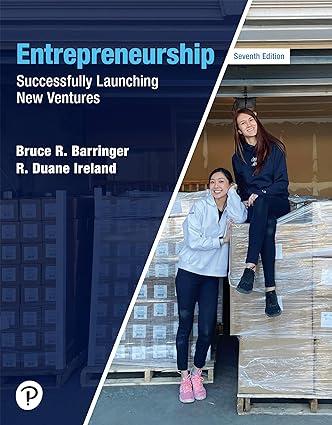In 2010, Tim Brown competed in the FIFA World Cup soccer championship. He was a midfielder for
Question:
In 2010, Tim Brown competed in the FIFA World Cup soccer championship. He was a midfielder for New Zealand, and it was the first time in 28 years for New Zealand to qualify for the World Cup. As a professional soccer player, Brown received quite a bit of gear from his team’s sponsors. He was particularly struck by the shoes. He felt they were over logoed, overdesigned, and overdone. Because of his reaction and beliefs resulting from it, he concluded that there was an opportunity to build a product that was about much, much less.
The idea that eventually became Allbirds started with that key insight—that it was possible to create an attractive performance shoe that had less branding and a simpler form. But the full idea for Allbirds evolved over time. During one off season of his soccer career, Brown visited a shoe factory. By touring the factory, he realized that the footwear industry, at least at that time, was “old-fashioned” with respect to how it designed and manufactured its products. Companies made most of their shoes from leathers and synthetics, leaving an opportunity to make shoes from more natural materials.
So, Brown’s idea now had two pillars: make shoes that are simpler in their design and make them using natural materials.
Brown’s soccer career ended in 2012, giving him more time to work on his idea. He focused on the materials side of his idea and received a \($200,000\) development grant from a New Zealand wool industry research group. A patented wool material that he could use to make shoes resulted from his work supported by the grant. The material was strong enough for a shoe and comfortable enough to wear.
Entrepreneurship Class and Kickstarter Brown’s next step was to attend graduate school.
His first stop was the London School of Economics and Political Science followed by a year as a visiting graduate student in the Kellogg School of Management at Northwestern University. He enrolled in an entrepreneurship class Kellogg offered. One requirement of this class was that students pitch a business idea.
Brown’s pitch was for a shoe company that would have a minimalist design made from natural materials (wool).
After the pitches, his professor pulled him aside. He said he thought the shoe concept was a terrible idea, that Brown lacked the knowledge needed to make shoes, and moreover, that producing shoes was difficult even for those with knowledge about how to do so. On the other hand, the professor acknowledged that Brown had determination; because of this, the professor suggested that he run a Kickstarter campaign to see if his idea had legs. Brown had a prototype and could produce about a thousand shoes. The professor predicted the idea would fail, allowing Brown to then turn to other ideas.
Brown took his professor up on the idea. He flew home to New Zealand for Christmas break and spent
\($700\) making a video pitch for a Kickstarter campaign.
Kickstarter is a crowdfunding platform where the idea is to raise money from the “crowd” rather than a single investor.
These campaigns fund a variety of projects, including business ideas. People contributing to a business idea receive some type of an amenity rather than equity in the business. In All bird’s case, a pair of shoes was the amenity investors received. The two-minute video pitch introduced
“The Wool Runner,” which is the name Brown picked for his shoes. The setting was a New Zealand sheep farm.....
Discussion Questions:
1. Which of the characteristics of a successful entrepreneur, discussed in the chapter, do you see in Tim Brown? To what degree do you think these characteristics have contributed to Allbirds’ success?
2. How does Allbirds “add value” for its customers?
3. To what degree do you think that “listening to customers”
contributes to Allbirds’ success? Provide an example of how listening to customers changed the way Allbirds marketed its products.
4. How do Brown and Zwillinger’s actions debunk the myth that entrepreneurs launch and run ventures just for the money? Provide at least two concrete examples.
Step by Step Answer:

Entrepreneurship Successfully Launching New Ventures
ISBN: 9780138091828
7th Edition
Authors: Bruce R. Barringer, R Duane Ireland





